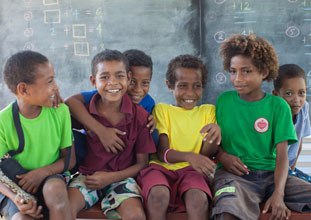Around 70 per cent of people in Cambodia have no access to electricity. Most villages in the Cambodian countryside are blanketed in darkness after the sun goes down.
Living without light puts children at risk. It also means children cannot study or complete their homework at night, leaving many students to fall behind.
Thirteen-year-old Tharin lives with her family in rural Kratie province, in the northeast of Cambodia. Like most villagers they live in a simple wooden house with a thatched roof and no access to electricity.
Tharin’s house has burned down twice due to accidents with their kerosene lamp. In one of the fires, her father’s leg was burned, leaving him permanently disabled.
“On that day I studied and forgot to put out the lamp as I fell asleep,” Tharin recalls. “When the lamp burned my house’s wall, I could smell it burning and felt that my hair was in the heat.”
Tharin called her mum for help, who in turn alerted her father and neighbour.
“When my dad tried to put out the fire, the lamp collapsed and the kerosene spilled on his trousers,” says Tharin.
For 12-year-old Kakada, living without light makes it hard to keep up with his studies.
“When I have no money to buy kerosene, I use fire sticks to cast light on my reading books so that I can read,” he says. “Sometimes I cannot study at home as I have no money to buy kerosene.”
The darkness also makes it dangerous to move around, says Kakada, adding: “When I go to the toilet at night, I cut my feet with pieces of glass and nails.”
Meet Tharin and Kakada in this video:
With more than 120,000 people in urgent need of shelter assistance after the worst cyclone in Fiji’s history, ensuring children and families have safe and adequate shelter is the top priority of emergency relief efforts being undertaken by Habitat for Humanity in partnership with ChildFund Australia.
Temporary evacuation centres are now reaching capacity, and there are fears that the scale of the disaster could increase rapidly, as power and communications to many remote islands remains cut off. More than 40 people have lost their lives, with fears that figure could increase.
Kamal, a resident of Tavua, a town on the main island of Vitu Levu, said: “The cyclone was my worst nightmare, it destroyed everything I owned. Our whole house was blown away. Please, we need shelter as my family has nowhere to stay. We don’t know what to do or how to start again.”
ChildFund’s relief and recovery effort is focused on families with vulnerable children. In the immediate term, this includes distribution by Habitat for Humanity of temporary shelter kits, which contain tarpaulins, roofing materials, access to toolkits and training on how to utilise the materials.
In addition, access to safe sources of water is critical, to ensure no additional loss of life, particularly among young children. Many existing water sources have been damaged or contaminated by the impact of the cyclone. ChildFund and Habitat for Humanity are providing household water filtration kits and will be conducting hygiene promotion among families.
ChildFund Australia CEO Nigel Spence said: “Right now, we must ensure that children are safely accommodated. While the cyclone has passed, its catastrophic consequences mean many children remain at risk. Providing a roof over their heads and access to safe drinking water are critical.”
Over the medium term, ChildFund will support Habitat for Humanity’s reconstruction efforts, as it is expected that thousands of family homes will need to be demolished and rebuilt entirely.








